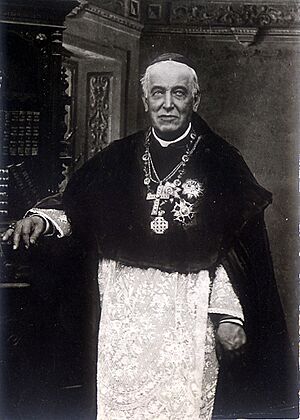Pelagio Antonio de Labastida y Dávalos facts for kids
Quick facts for kids The Most Reverend Pelagio Antonio de Labastida y Dávalos |
|
|---|---|
| Archbishop of Mexico | |
 |
|
| See | Mexico |
| Enthroned | March 19, 1863 |
| Reign ended | February 4, 1891 |
| Predecessor | José Lázaro de la Garza y Ballesteros |
| Successor | Próspero María Alarcón y Sánchez de la Barquera |
| Orders | |
| Ordination | November 10, 1839 |
| Consecration | July 8, 1855 |
| Personal details | |
| Born | March 21, 1816 Zamora, Michoacán |
| Died | February 4, 1891 (aged 74) Yautepec, Morelos, Mexico |
| Nationality | Mexican |
| Denomination | Roman Catholic |
| Previous post | Archbishop of Puebla (1855–1863) |
|
Pelagio Antonio de Labastida y Dávalos
|
|
|---|---|
| Regent of the Mexican Empire with José Salas and Juan Almonte |
|
| In office 11 July 1863 – 10 April 1864 |
|
| Monarch | Maximilian I of Mexico |
| Succeeded by | Maximilian I of Mexico |
| Personal details | |
| Born | March 21, 1816 Zamora, Michoacán, Mexico |
| Died | February 4, 1891 (aged 74) Yautepec, Morelos, Mexico |
Pelagio Antonio de Labastida y Dávalos was an important Mexican leader. He was born on March 21, 1816, in Zamora, Michoacán. He passed away on February 4, 1891, in Oacalco, Morelos. Labastida y Dávalos was a Roman Catholic church leader, a lawyer, and a politician.
He played a key role in Mexican history. He was part of the group that invited Maximilian of Austria to become the Emperor of Mexico. This happened during a time when France had invaded Mexico.
Contents
Pelagio Labastida's Life and Career
Pelagio Antonio de Labastida y Dávalos had a long and influential career. He was involved in both the church and politics. His life saw many changes in Mexico.
Early Life and Church Career
Labastida began his studies at the Seminario Conciliar of Morelia in 1830. He later became a professor and director there. Some of his classmates became important figures. These included Clemente Murguía, who became an archbishop, and Melchor Ocampo, a future foreign minister.
He became a priest in 1839. Labastida was known for his strong conservative views. He often spoke against liberal ideas and groups like the Freemasons. In 1854, he became a canon in Morelia. He openly disagreed with liberal thinkers like Melchor Ocampo.
In July 1855, he was made the bishop of Puebla. This happened after conservatives gained power. He even used church money to support a revolt in December 1855. This was because the government wanted to sell some church properties.
A Time of Political Change
When liberals returned to power in 1857, Labastida went to Europe. He continued to support the conservative government from there. Later, when conservatives were in power again in 1859, he was called back to Mexico.
He was exiled to Europe again later. In 1862, he visited Maximilian of Habsburg. The next year, he met Pope Pius IX in Italy. On March 18, 1863, the Pope named him the archbishop of Mexico.
The French Intervention in Mexico
In 1862, France invaded Mexico. French General Forey entered Mexico City in June 1863. He called a meeting of important people, called the Council of Notables. They met to discuss creating an empire in Mexico.
The group agreed on having an empire. However, they disagreed on who should be the emperor. It was Labastida who suggested Maximilian of Austria. Everyone agreed to this idea.
On June 21, 1863, Labastida was named to the Regency of the Empire. This was a temporary government before Maximilian arrived. He served with Juan Nepomuceno Almonte and José Mariano Salas. This group sent a message to Europe to offer the crown to Maximilian.
Differences and Later Life
Labastida was removed from the Regency on November 17, 1863. This was due to disagreements with General François Achille Bazaine. Bazaine was the commander of the French troops. Labastida did not agree with Bazaine's plans for church property. Juan Bautista de Ormaechea replaced him.
His relationship with Maximilian also became difficult. Maximilian decided to allow freedom of religion in Mexico. Labastida did not support this idea.
After the Empire ended in 1867, Labastida returned to Europe. He remained the head of the Catholic Church in Mexico. He attended the First Vatican Council from 1869 to 1870. In 1871, President Benito Juárez allowed him to return to Mexico.
See also
- List of heads of state of Mexico
- Conservatism in Mexico
- French Intervention in Mexico
- First Vatican Council
- History of Roman Catholicism in Mexico

